Researching an Area of Language
Karl J. Hannay, who completed a BA Social Science degree at the University of Westminster, London, England, 1996, gained his Certificate in English Language Teaching to Adults (CELTA) at Woolwich College, London, United Kingdom, 1999, and an MSc in TESOL and Applied Linguistics from the University of Stirling, Scotland, 2017. English language teacher since 1999: Egypt, Sudan, Turkey, Saudi Arabia, Kuwait, Libya, and Oman.
Dr Robin Usher wrote `Jungian Archetypes: Robert A. Heinlein`, PhD by thesis, Hull University, England, 1992; Trinity College, London, TESOL Certificate, 1995. Taught English language in England; Hungary, Poland, Russia, Syria, Saudi Arabia, Sudan, Oman, Libya, Turkey, Azerbaijan, and China. ELT article, ‘Learning to Study’, Hungarian Institute for Educational Research (HIER), Educatio (3), 1995. SF writer, e.g., 'All For Naught Orphan Ufonaut', Shelter of Daylight (2010), and critic, e.g., Foundation, ‘Robert A. Heinlein: Theologist?’ (54); `Male And Female He Created Them Both: Beyond The Archetypes` (112), and ‘Zippo Marx’, Cinema Journal (CINEJ), Vol.6, 1, 2017. Email: robika2001@yahoo.co.uk .
Introduction
Teaching English in the Middle East, where Islam is the predominant religion, people are forbidden to talk about it with foreigners. The solution is to avoid the topic; for fear of being offensive: or saying something misconstrued. However, honesty is important with Islamic people, who`re genuinely interested in other cultures, because it helps with English usage, although the real difficulty is that Moslems are exhorted to fulfill what they’re taught to see as their duty to convert others to belief in Islam, which is based on the Koran (610-30 C.E.), dictated by the angels to their Prophet Mohamed, as the word of God, who is ‘Allah’ in their Koran, so discourse with Christianity, for example, is fraught with resistance, which is why the subject is taboo, or haraam in Arabic.
Composed of mind, body and spirit, humanity should be developing, which is what students want to hear. It`s a spiritual decision to keep fit by going to the gym, eat the appropriate foods, and maintain general well-being, so spirituality is a general concern, so basic to English language use. As it`s a decision, intellectually, to write an essay, or put mental effort into preparing for an exam, spirit and religion are proximates, because God is often invoked as an aid through prayer. Spiritually religious people struggle to improve; practicing charity, kindliness, humility, patience and diligence; for example. For Moslems going to a mosque, or for Christian churchgoers, there are feelings of religiosity, but not necessarily the spirit of improvement. Consequently, it`s useful to distinguish between `spiritual` and `religion`; for example. For some prayerful `religious` means repetition, that is, remembering prayers, and ritual observances, whereas a reliance on the spiritual entails a less structured belief in memory and ritual, that is, faith, which is why Moslem believers in Islam describe themselves as ‘the faithful’.
Although there is semantic overlap between the terms, ‘spiritual’ and ‘religious’, they aren’t synonyms. Corpus linguistics techniques on the British National Corpus (BNC), and the Corpus of Contemporary American English (COCA), are useful in investigating usage. Consequently, the examination of similarities and differences between the terms `religious` and `spiritual` ought to begin with an introduction of the corpora, BNC and COCA, before focusing on the use of the terms in the sub-corpora of newspapers.
Definitions
The Collins online COBUILD Learner’s Dictionary defines `religious` as having `belief in a god or gods` (https://www.collinsdictionary.com/dictionary/english/religious). The definition for `spiritual` is, ‘peoples thoughts and beliefs’, and/or ‘related to peoples religious beliefs’ (https://www.collinsdictionary.com/dictionary/english/spiritual), which implies they’re synonyms. However, spirituality is related to belief, which belief might be religious, but not necessarily so. However, as Collins` definitions highlight difficulties in clearly defining usage, there’s semantic overlap. In other words, there are mutually exclusive aspects of meaning to the terms ‘religious’ and ‘spiritual’, but without sufficient contextual information for the speaker, reader, or writer to determine how words are used with appropriateness, errors occur. Students need to differentiate between words that appear with synonyms (Walker, C., 2011; Alabader, Y. B., 2011), which is where corpus linguistics proves insightful.
Literature review
Synonymy links vocabulary items, so facilitates acquisition (Partington, A., 1989: 39). Usage avoids repetition within texts, which adds nuance to meaning and keeps the mind of the reader or listener alert, rather than numb with monotony, while allowing users opportunities to construct sentences communicative across a range of disparate themes; notwithstanding semantic similarity. Synonymy is `having the same completed sense`, though not the same absolute frame of reference. The types, `strict` and `loose`; are worthy of discussion. Strict (absolute) synonyms are used interchangeably. Substitution of a word for another doesn`t result in change in meaning; style, and connotation: in terms of what is said or written (Jackson, H., and Amvela, E., 2000). Such synonyms are rare or non-existent (McCarthy, M., O’Keeffe, A., and Walsh, S., 2010). Corpus-based studies of synonymous adverbs, for example, ‘broadly’ and ‘largely’ (Tognini-Bonelli, E., 2001), and ‘finally’ and ‘lastly’ (Tsui, A., 2005), exhibit the usefulness of distinguishing. As Alabder (2001) states, corpus analysis is an appropriate method for understanding the similarities and differences between seemingly interchangeable words, so allowing us to present more specific criteria and suggestions for usage.
Methodology
Data was taken from BNC and COCA. The BNC is a 100 million word collection of samples of spoken and written language from a wide range of sources designed to represent a wide cross-section of British English from the early 1990s. The written part (90%) includes; for example, extracts from regional and national newspapers, specialist periodicals and journals, academic books, fiction, published/unpublished letters and memoranda, and school and university essays; amongst other kinds of text.
The spoken part (10%) consists of orthographic transcriptions of unscripted informal and formal spoken language. COCA is the largest freely-available corpus of English, and the only large and balanced corpus of American English. The corpus contains more than 520 million words of text, and is equally divided among spoken, fiction, popular magazines, newspapers, and academic texts. Including 20 million words each year from 1990 to 2015, the corpus is updated regularly, so COCA and BNC are representative. According to Leech, G. (1991), such a corpus’ findings are general to the language as a whole; or a specified part of it.
Collocation
A key concept in corpus investigation bearing close examination is collocation, which refers to the ‘regular and predictable co-occurrence of words in a text or an utterance’ (Coulthard, M., et al, 2000, p. 77). McCarthy (1990) characterizes collocation as a ‘marriage contract between words’ (p. 12) and states ‘marriage is stronger between some words than others’. Originally coined as a technical term by Firth, J. R. (1957), the collocation of a given word was said to be ‘a statement on the habitual or customary placing of a word’ and that ‘a word is known by the company it keeps’, which was later extended by, among others, Sinclair, J. (1991), Hoey, C. (1991), and Hunston, S. (2002), to include lexical items that appear with greater random probability than their individual frequencies would lead us to expect. Collocation refers to the `co-occurrence of words` (Sinclair, J., 2000: 200), reflecting their tendencies to appear near each other in line with the idiom principle; for example:
‘Red sky at night, shepherd’s delight;
Red sky in the morning, shepherd’s warning.’
(Matt: 16. 2-3)
The words co-occurring are ‘red’, ‘sky’, and ‘shepherd’, that is, the verse from the New Testament of the Christian Bible, which is based on the 1395 translation, directed by John Wycliffe, about the perceived consequences of a change in the weather meaning a pleasant day’s work, or conversely, uses a collocation. The importance for the study is that, although collocations are useful in transmitting information idiomatically to children, that is, the morning will be fine if there’s a red sunset, language students need to know a much wider variety of words, which may seem merely synonyms, but they have other meanings in different contexts; for example, after a shepherd/pastor has rested, he/she has to preach to the congregation the following day. Consequently, the learning of synonyms is useful in avoiding repetition, that is, rote responses and actions, which may be religious, but not necessarily spiritual, whereas knowledge of the synonym ‘shepherd’, as meaning ‘pastor’, enriches the spirit and mental ability of the language student. The idiomatic poem is repetitive, which is ‘good’ English only insofar as it’s educative of more than weather phenomenon. The synonym ‘shepherd’ within the collocation ‘red sky’ is designed for the student to learn, which is what they need to know from their teacher. Synonyms are multivalent linguistic tools designed to communicate across a wide range of meaningful contexts; so are worth learning.
There are a number of ways to determine the level of significance between instances of words within corpus linguistics (Xiao, R., and McEnery, T., 2006). The statistical test looked at MI (mutual information) scores; a measure of the strength of association between words that compares the expected (or random), and actual instances of co-occurrence. A score of above 3 was significant, that is, a strong indicator of association, and high scores for collocates were examined.
Frequency is an important concept in linguistics (Linquist, H., 2009). The number of examined words appearing in a corpus are their ‘raw frequency’, which presents no problems with corpora of equal size. However, most corpora are not of an equal size, so what’s compared are normalized frequencies per thousand or million words, which necessitated comparing the main corpora and sub-corpora of BNC and COCA.
Further scrutiny of collocation and phraseology reveals the semantic prosodies of word combinations; the linguistic phenomenon of words or phrases becoming positively or negatively colored in meaning through their frequent collocates. (Louw, B., 1993). The perceived tendency towards using collocates is ‘semantic preference’, and assists in creating a profile of a word, for example, ‘shepherd’, showing how certain collocates can be bound together in extended units of meaning (Sinclair, J., 1996).
Concordance
Concordance lines are another starting point for the study of collocations using corpus linguistics tools, as Kennedy, G. (1998) says (p. 247). Concordances are lines of text of a given length featuring the word being investigated; otherwise known as the node in the center of the page with its surrounding context; for example, ‘shepherd’. This context is then examined, and patterns, if any, are then drawn from the relationship between words. The expanded context of concordance lines is key because, as Kennedy, G. (1991) says, ‘collocates are sometimes separated by intervening words.` according to Biber, D., Conrad, S., and Reppen, R. (1998), `... the simplest way to identify collocate pairs is by their frequency, which can give a sense of the most common collocational associations ..’. Posing some difficulties for non-native English language students, who’re expecting to find unalterable signifiers in their collocates, is high frequency collocates of a given node consisting of high frequency words, so collocating frequently with words other than the examined, for example, ‘blood-red’, where blood collocates with red, rather than sky, points the student’s mind in the direction of the shepherd, Jesus, as their pastor, that is, the ‘blood of the lamb’ they’re washed in; to be cleansed from sin during baptism and/or communion: but that’s difficult.
Quantitative and qualitative
Both quantitative and qualitative techniques are required; affording the explanation that a shepherd can be a pastor, ‘The Lord is my shepherd; I shall not want.’ (Ps: 23. 1) The Lord is God; not the local landowner. God isn’t a synonym for the aristocracy. Although the pastor speaks from the Bible the word of God, in Christianity ‘the Lord’ is Jesus, who is recorded in the New Testament as saying: ‘Love your neighbor as you love yourself.’ (Mk: 12. 31) Consequently, Jesus is synonymous with ‘shepherd’, which is educative. Students of English resort to synonyms to avoid learning more words, because they have a sufficiency, whereas the result is sterile repetition, for example, congregations have a shepherd, because they don’t need the word ‘pastor’. However, as pastor is synonymous with shepherd in churchgoing terms, learning that synonyms are found with collocations, because that’s their linguistic use, is what language students want to know; for example, the lyrics to the musical composition, ‘New Year’s Day’, from the album, War (1983), by the Irish rock group U2, is about hopes for a resolution to the problem of sectarian violence between Protestants and Catholics in Northern Ireland, which requires a knowledge of what the synonyms are that the collocations ‘blood-red’ and ‘red sky’ refer to, that is, war and the shepherd, Jesus:
‘Under a blood-red sky
A crowd has gathered in black and white.
Arms entwined, the chosen few,
Newspapers say, it says it's true.
And we can break through,
Though torn in two we can be one.’
Blood is synonymous with war, so the collocations, ‘blood-red’ and ‘red sky’ have different associations and meanings, that is, blood-red is a mythological reference to the Roman war god, Mars, for example, because Mars is the ‘red planet’ associated with masculinity in opposition to Venus, goddess of love, while the collocation ‘red sky’ is associated with the Lord God, and the Lord Jesus. As the shepherd, who is perceived as being synonymous with the pastor, God, of the 23rd psalm of the Old Testament of the Jewish Bible, that is, the Talmud and Torah, which is the history and law of the Jews, Jesus’ New Testament had relevance for the future of Protestants and Catholics torn apart by differences, which those who saw Protestantism and Catholicism as being synonymous with the acceptance of Jesus’ teaching, couldn’t comprehend: ‘Love your neighbour as you love yourself.’ (Mk: 12. 31) In short, the collocations ‘blood-red’ and ‘red-sky’ respectively hold the key to the synonyms; war, that is, ‘blood-red’ Mars, and Christianity’s ‘shepherd’. Henry VIII’s decision to become head of the English Protestant church in 1531, as apart from the then Pope, Clement VII, in Catholicism’s city of Rome, Italy, affords greater meaning to the juxtaposition of the collocations, ‘blood-red’ and ‘red sky’, because his role as England’s pastor resulted in civil war between Protestants and Catholics, whereas understanding that the color is red doesn’t confer any meaning other than that for a lazy student.
Findings
The total number of instances for the occurrence in the BNC of the word `religious` is 6,443, or `hits` in 1,194 different texts. The normalized frequency is 65.5 per million words (pmw). The word `spiritual` occurs 2,300 times, or `hits` in 648 different texts. The normalized frequency is 23.39 instances pmw. The total number of BNC texts is 4,048 with 100 million words (Source: http://bncweb.lancs.ac.uk). As represented by data from corpus findings, `religious` prevails over `spiritual` in ordinary usage, while both are evenly distributed over the corpora in approximately 1 in 4 of main texts. The BNC raw frequency data for `religious` was 6,376 and for `spiritual` 2,281. The COCA raw data for each of these words was 57,898 and 21,370 respectively. Though not comparable, the figures arguably show `religious` to be used more in general English than `spiritual` across both corpora at a ratio of approximately 3:1.
Although the different frequency counts included in the sub-corpora of the BNC give an indication of how the words are used pmw, it’s evident that the collocations, ‘religious leader’ and ‘negro spiritual’, are mutually exclusive linguistic constructs, that is, ‘religious’ isn’t synonymous with ‘spiritual’, because that’s a type of song sung by black slaves; for example, in the deep South of the United States, during the period prior to the American Civil War (1861-5) waged by the Northern States and the US government to manumit them.
Node words
For students of English language, collocations represent the requirement of understanding the synonym within its concordance, because that’s how speech and writing improves. Although ‘Old Folks at Home’ is a ‘religious song’, written by Stephen Foster in 1851, its taxonomy is that of ‘negro-spiritual’, so concomitant to understanding the difference between collocation and synonym is the history of slavery, which is an improvement in linguistic use dependent on a deeper knowledge of ‘spiritual’ as being a part of a concordance referred to by a collocation as its node word:
‘Way down upon de Swanee Ribber,
Far, far away,
Dere's wha my heart is turning ebber,
Dere's wha de old folks stay.’
Both ‘religious’ and ‘spiritual’ have different frequencies pmw. The word `religious` across all the sub-corpora is higher on a ratio of 2 or 3 to 1 compared with `spiritual`. Perhaps less so in the sub-corpora for magazines where `religious` is used slightly more, which is attributable to readers’ interests for softer news, or less serious articles during leisure time. ‘Spiritual-ity’ encompasses a broader range of personal interest subjects; such as meditation, yoga, and personal growth.
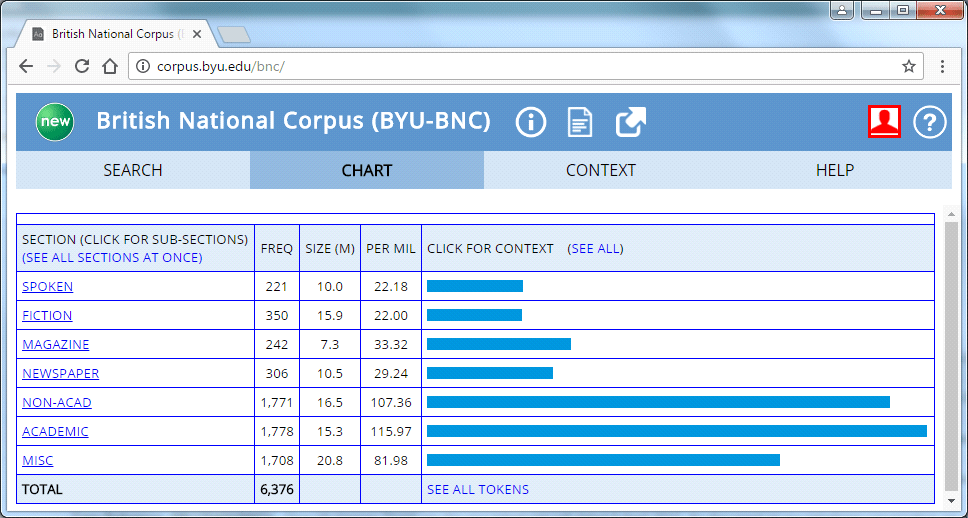
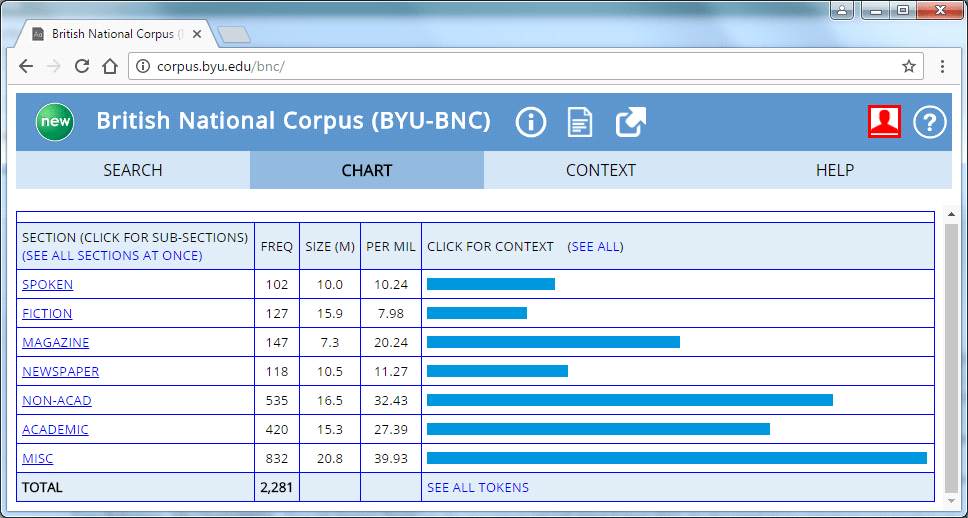
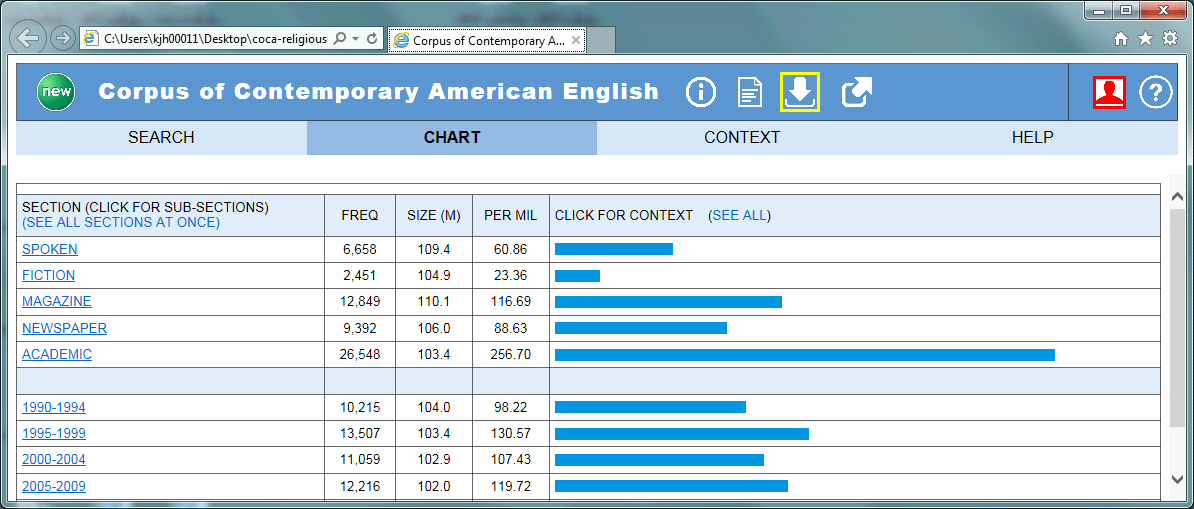
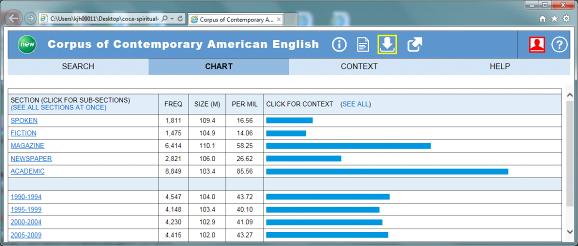
In terms of ratios, BNC and COCA patterns are similar, with `religious` used more across all sub-corpora (pmw). There`s a higher number pmw for `religious` across all sub-corpora compared to BNC except for fiction, which requires further investigation to be accounted for. Hypothetically, American society is more religious than the UK`s, or there`s greater focus on ‘religious’ concepts, as well as `spiritual`, because of US’ President George W. Bush’s 2003 declared ‘War on Terror’, and the subsequent scrutiny of Islam and Moslem culture, after the emergence of the Al Qaeda terror group, which hijacked civil airliners to crash into the Twin Towers of the World Trade Centre on Manhattan island in New York city on September 11, 2001, while the subsequent proclamation, by the advocates of the Independent Levant (IL), of Abu Bakr Al Baghdadi as its Caliph, similarly resulted in an increase in the frequency of the usage of the words ‘religious’ and ‘spiritual’ in societal discourse, with the context suggesting ‘religious’ as being more applied to Islamic matters, while ‘spiritual’ was used to refer to Christian issues, because of the pivotal role of the Holy Spirit in Jesus’ teaching, and societies based on Western Christianity.
Although BNC is a static corpus, which hasn`t been added to significantly since the 1990s, COCA is dynamic. However, the fact that pmw there’s a much larger frequency for `religious` supports the argument that terror promoted the use of concepts associated with the word ‘religious’ and ‘Islam’, which had mainly negative connotations, while the word ‘spiritual’ was used positively, and in contrast to the subject topic of pertinent concordances; for example, the relatively new collocation of ‘religious terror’, when juxtaposed with Jesus’ older, and more desirable notion, conveyed by the collocation ‘spiritual peace’.
Discourse
Concentrating on the sub-corpora of newsprint, the likely differences in use of news discourse across British and American publications could be determined, and also whether `religious` or `spiritual` collocated negatively or positively. According to Fairclough, N. (1989), media power is cumulative, and profoundly influences readers by producing discourse; or helping reshape it. Becker, H. (1972), describes a ‘hierarchy of credibility’, whereby powerful people`s opinions are accepted, as it`s assumed they have the most up to date and accurate information; summarized by Hall, S., et al (1978):
‘... the result of this structured preference given in the media to the opinions of the powerful is that these “spokesmen” become what we call the primary definers of topics’ (p. 58).
In short, opinion has an influence upon whether Islam is ‘religious’ or ‘spiritual’, whereas it’s a fact that Sufism is the mystical branch of Islam, which means ‘spiritual terror’ would derive from there, while ‘spiritual’ remains an English word influenced by powerful opinion, that is, public opinion could be influenced away from using the collocation ‘spiritual terror’ by Sufism, so emboldening Christianity’s belief that its spiritual power is unshakeable. A basic word search in both the BNC and COCA for collocational patterns with 4 noun words to the left and right within the sub-corpora of newspapers used relevance to sort and determine MI score with a minimum frequency of 5 `hits` as the criteria.
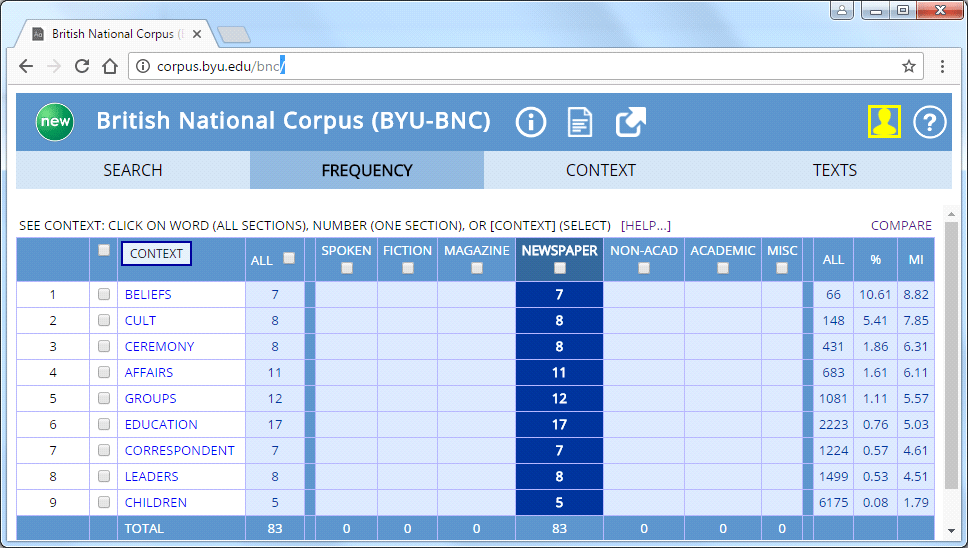

Searches in the BNC list reveal collocations with neutral words that haven`t apparent negative prosody, and `cult` was the only word appearing to have an immediate negative connotation, which was confirmed from concordance analysis. Some of the neutral words were researched using concordancing, which results are listed.
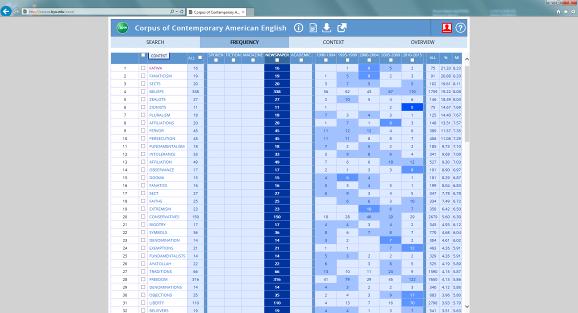
Interestingly, the word `religious` produced words with a strong MI score; collocating negatively. Concordance analysis was used to try to determine the surrounding discourse and co-text, and so explain the MI score.
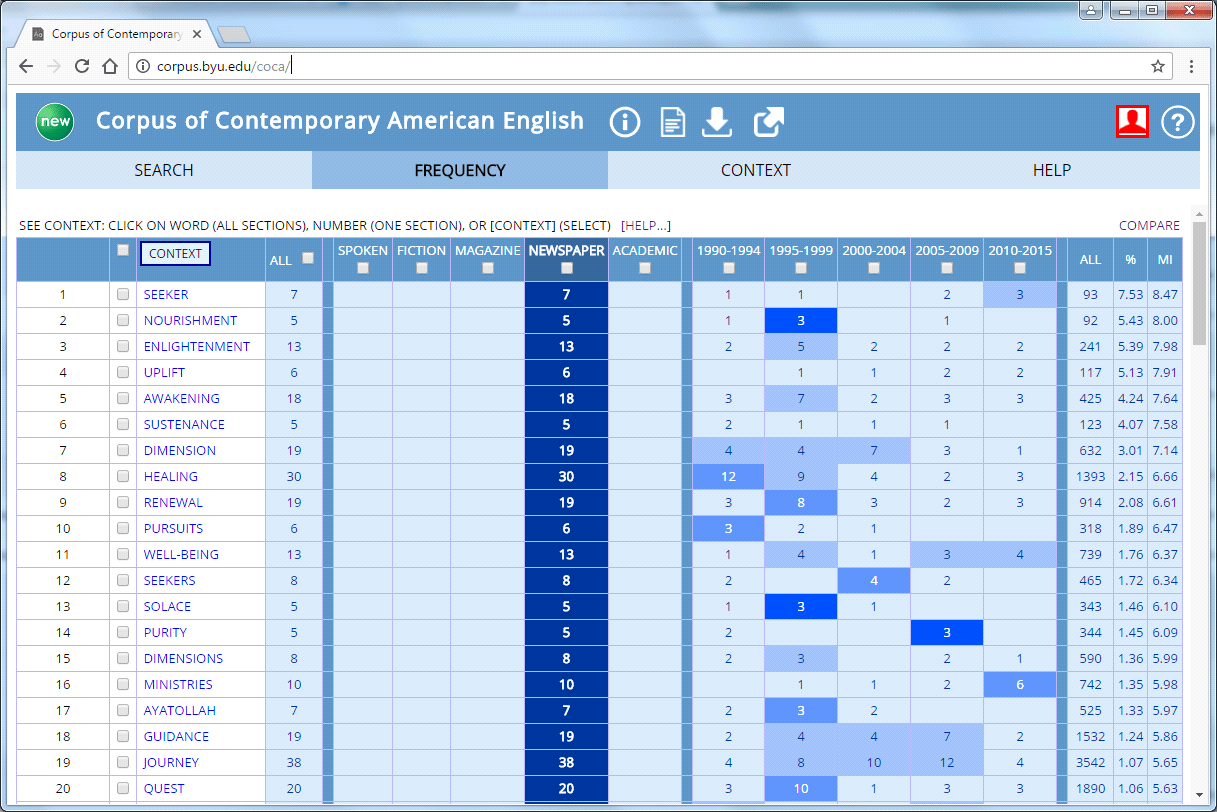
Words that collocate neutrally with the word `spiritual` are `seeker, dimension, pursuits, well-being`, etc., and words that collocate positively are `enlightenment, healing, purity, uplift`, etc. The word ‘Ayatollah’ appears in stark contrast, because of its primary associations with the country of Iran`s volatility, where Ayotollah Khomeini instigated a Revolution against the Shah in 1978, so resonating a discourse relationship of war and conflict in terms of the word`s collocations with `spiritual` and `religious`.
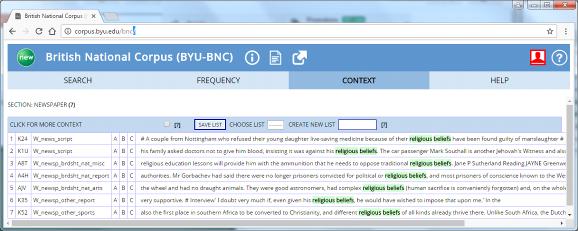
Collocate belief in concordance lines reveals negative discourse prosody, which is apparent in the term `Ayatollah` being used in the reporting of negative news. In the first instance, religious beliefs are connected with a fatwā, that is, an Islamic death sentence imposed by Khamenei upon the Indian subcontinent’s Moslem from Mumbai, Salman Rushdie, on February 14th 1989, for writing in his novel, The Satanic Verses (1988), about the An-Najm chapter of the Koran, ‘The Unfolding’ (53. 19-22), concerning three goddesses, al-Lāt, al-‘Uzzá and Manāt, suggesting that women were originally hermaphroditic, ‘Are you to have the males, and he the females?’ The second instance of negative reporting features a terrorist bomb attack upon Khamenei, while the last appears a neutral announcement of a TV appearance by the Ayatollah.
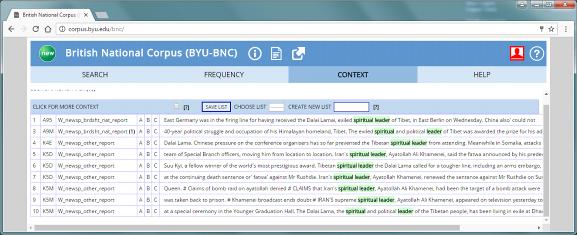
A more neutral term would appear to be `spiritual leader`, but in concordancing it`s invariably linked with political discourse and leans to a more negative discoursal prosody. News tends to be focused on negative articles anyway, so it`s difficult to determine actual usage of the term `spiritual leader`, whereas ‘spiritual home’ as a collocate has positive prosody in its surrounding text.
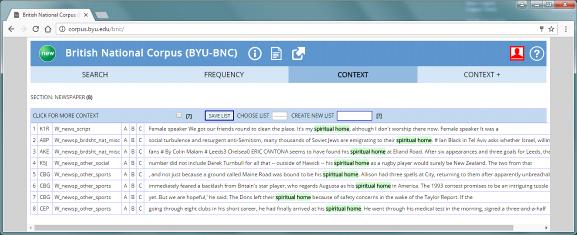
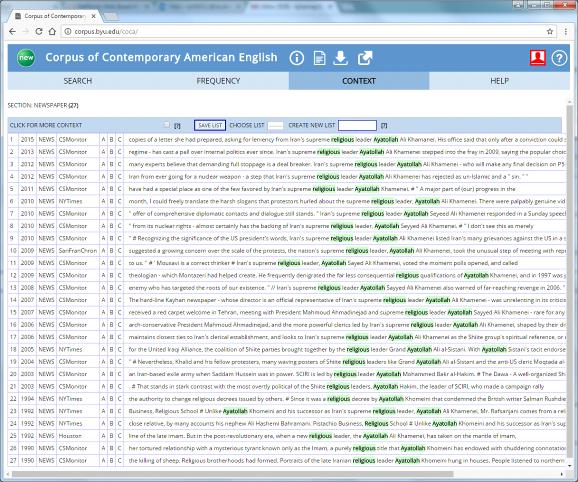
Although the context for `religious` and `Ayatollah` is political, its usage tends towards the informative and respectful. The words `spiritual` and `Ayatollah` are used as synonyms; for example ‘supreme religious leader’ precedes Sayed Ali Khamenei`s name.
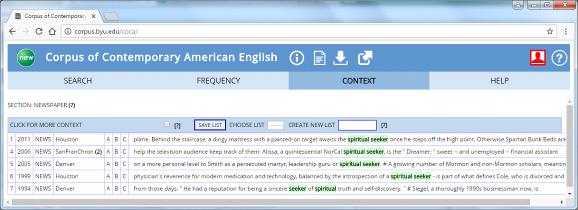
The term `spiritual seeker` frequently occurs with ‘dreamer’, ‘sweet’, ‘truth’, and ‘self-discovery’, although some words denote negativity; for example, ‘persecution’ and ‘martyr’, which more frequently occur with the term `religious`.
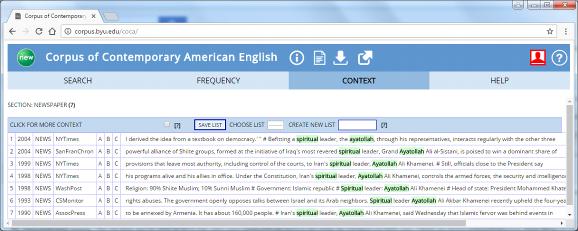
`Ayatollah` used with `spiritual` doesn`t appear to have strong negative prosody. Although it appears to be used in the context surrounding discourse to do with Iran, it`s politically informative and so collocates neutrally. The collocational relationship is strictly synonymous with `religious Ayatollah`, that is, in the case of `Ayatollah`, `religious` and spiritual` seem generally interchangeable for English speakers, which is alarming from the perspective of a public opinion possibly influenced by Islamic Sufism to be unable to differentiate between Islamic religious extremism and Islamic spirituality, which is potentially terroristical and manipulative through spiritual Sufism.
Conclusion
Corpus study reveals detailed information about apparent word synonymy and collocational relations with respect to these words and the significance of this, both in everyday discourse and communication, but more specifically its impact on language and meaning, through the very powerful sub-corpora of news media. Both ‘religious’ and ‘spiritual’ are words used to some extent as synonyms. The word `religion` is used more commonly in everyday discourse; across a wide range of genre types: according to BNC and COCA. Analysis shows a negative collocational statistical relationship between `religious` and its collocates with high MI scores in news discourse in the United States, which appears the result of the `War on Terror`, although the concordance text either side of the node suggests not exclusively so. In the BNC, which wasn`t added to since the 1990s, there`s negativity surrounding ‘religious’, although not such negativity as within the contemporary American context. `Spiritual` wasn`t unaffected either in terms of negative discourse prosody. It`s difficult to draw conclusions as news media`s concentration on newsworthiness tends to be negative. Quantitative lists for negative and positive prosody are inconclusive, without qualitative analysis, which was illustrated by ‘Ayatollah’ used with `religious` and `spiritual` in COCA news sub-corpora, where it was found to have a neutral standing. With corpus analysis, it`s difficult to simplify and clearly define terms; definitions and meaning depend on context and change with time. Religion and belief are increasingly important in world affairs, and as news has such an important impact on society at large, the meaning of the terms as used remains of paramount importance to native speakers in English usage, and non-native speakers, who may perforce unwisely use collocations with synonyms without any understanding of the depth of meaning in their concordances.
References
Alabader, Y. B. (2001) Comparing the Usage and Distribution of Two Near Synonymous Words: Error vs Mistake. MA, University of Manchester.
Becker, H. (1972) 'Whose side are we on?' Douglas, J.D. (ed.) The Relevance of Sociology.
Biber, D., Conrad, S., and Reppen, R. (1998) Corpus Linguistics: Investigating Language Structure and Use. Cambridge University Press.
Coulthard, M., Knowles, M., Moon, R., and Deigan, A. (2000) Lexis. 2nd ed. The University of Birmingham.
Fairclough, N. (1989) Language and Power. London: Longman.
Firth, J. R. (1957) Papers in Linguistics: 1934-1951. London: Oxford University Press.
Hall, S., Critchener, C., Jefferson, T., Clarke, J. and Roberts, B. (1978) Policing the Crisis: Mugging, the State, and Law and Order. London: Macmillan.
Hoey, C. (1991) Patterns of Lexis in Texts. Oxford: Oxford University Press.
Hunston, S. (2002) Corpora in applied linguistics. Cambridge University Press.
Jackson, H. and Amvela, E. (2000) Words, meaning and vocabulary. London: Cassell.
Kennedy, G. (1998) An Introduction to Corpus Linguistics. Essex: Pearson Education Ltd.
Leech, G. (1991) The state of the art in corpus linguistics. Aijmer, K., and Altenberg,B. (eds.), English Corpus Linguistics.
Lindquist, H. (2009) Corpus Linguistics and the description of English. Edinburgh: Edinburgh University Press.
Louw, B. (1993) Irony in the text or insincerity of the writer: the diagnostic potential of semantic prosodies. M. Baker (ed.) Text and Technology, pp. 157-176.
McCarthy, M. (1990) Vocabulary. Oxford University Press.
McCarthy, M., O'Keeffe, A., and Walsh, S. (2010) Vocabulary Matrix. Understanding, learning, teaching. Croatia: Heinle.
Partington, A. (1989) Patterns and Meanings. Philadelphia, PA, USA: John Benjamins Publishing Company.
Sinclair, J. (1991) Corpus, Concordance, Collocation. Oxford: Oxford University Press.
Sinclair, J. (1996) Collins COBUILD Learner's Dictionary. Harper Collins Publishers Ltd.
Sinclair, J. (2000) Lexical grammar. Naujoji Metodologija, 24, pp. 191-203.
Tognini-Bonelli, E. (ed.) (2001) Corpus Linguistics at work. (Vol. 6) John Benjamins Publishing.
Tsui, Amy B. M. (2005) ESL teacher's questions and corpus evidence. International Journal of Corpus Linguistics, 10 (3), pp. 335-356.
Walker, C. (2011) How a corpus-based study of the factors which influence collocation can help in the teaching of business English. English for Specific Purposes, 30 (2), pp. 101-112.
Xiao, R., and McEnery, T. (2006) Corpus Based Language Study. Routledge Applied Linguistics.
Please check the English Language Update for Teachers (C1-C2) course at Pilgrims website.
Researching an Area of Language
Robin Usher, HungaryA Grim Cloud with a Linguistic Silver Lining …
Tim Bowen, UKNeologisms in the Modern Online Discourse 2020
Sofya Kulchikenova, Kazakhstan